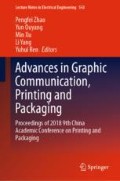Abstract
This paper is aimed at the key technology of digital printing in the textile industry. According to the color reproduction characteristics of digital printing, a color prediction model based on Particle Swarm Optimization (PSO) was proposed to optimize the three-layer BP neural network, solving the problem that BP neural network is easy to fall into local minimum value through optimization of weights and thresholds, which effectively improved the digital printing color prediction accuracy. The experimental and industrial application results show that the prediction accuracy of this paper is higher than BP neural network model and the Yule-Nielsen modified Neugebauer model these two mainstream algorithms, which is more in line with the practical needs of digital printing industry applications.
Access this chapter
Tax calculation will be finalised at checkout
Purchases are for personal use only
References
Yun, Q., & Wang, Q. (2017). Research on spectral prediction model based on textile digital printing. Journal of Hangzhou Dianzi University, 37(6), 67–72.
Yu, H., Liu, Z., & Tian, Q. (2015). Multi-color prediction model based on BP-NN optimized by GA and PCA. Chinese Journal of Luminescence, 36(6), 711–717.
Wu, Z., Zhao, Y., Luo, X., & Du, H. (2017). License plate recognition technology based on PSO-BP neural network. Journal of Sun Yat-sen University, 56(1), 46–52.
Zeng, W., Wei, R., & Chen, H. (2008). Research and application of BP neural network based on improved PSO algorithm. Computer Technology and Development, 18(4), 49–51.
Suresh, A., Harish, K. V., & Radhika, N. (2015). Particle swarm optimization over back propagation neural network for length of stay prediction. Procedia Computer Science, 46, 268–275.
Acknowledgements
This work is funded by National Key Technology Research and Development Program of the Ministry of Science and Technology of China (2012BAH91F03) and Hangzhou Dianzi University Graduate Innovative Research Fund (CXJJ2018017) and Digital Imaging Theory-GK188800299016-054.
Author information
Authors and Affiliations
Corresponding author
Editor information
Editors and Affiliations
Rights and permissions
Copyright information
© 2019 Springer Nature Singapore Pte Ltd.
About this paper
Cite this paper
Lu, S., Wang, Q., Yang, P., Zhang, W. (2019). Research on Digital Printing Color Prediction Model Based on PSO-BP Neural Network. In: Zhao, P., Ouyang, Y., Xu, M., Yang, L., Ren, Y. (eds) Advances in Graphic Communication, Printing and Packaging. Lecture Notes in Electrical Engineering, vol 543. Springer, Singapore. https://doi.org/10.1007/978-981-13-3663-8_6
Download citation
DOI: https://doi.org/10.1007/978-981-13-3663-8_6
Published:
Publisher Name: Springer, Singapore
Print ISBN: 978-981-13-3662-1
Online ISBN: 978-981-13-3663-8
eBook Packages: EngineeringEngineering (R0)

